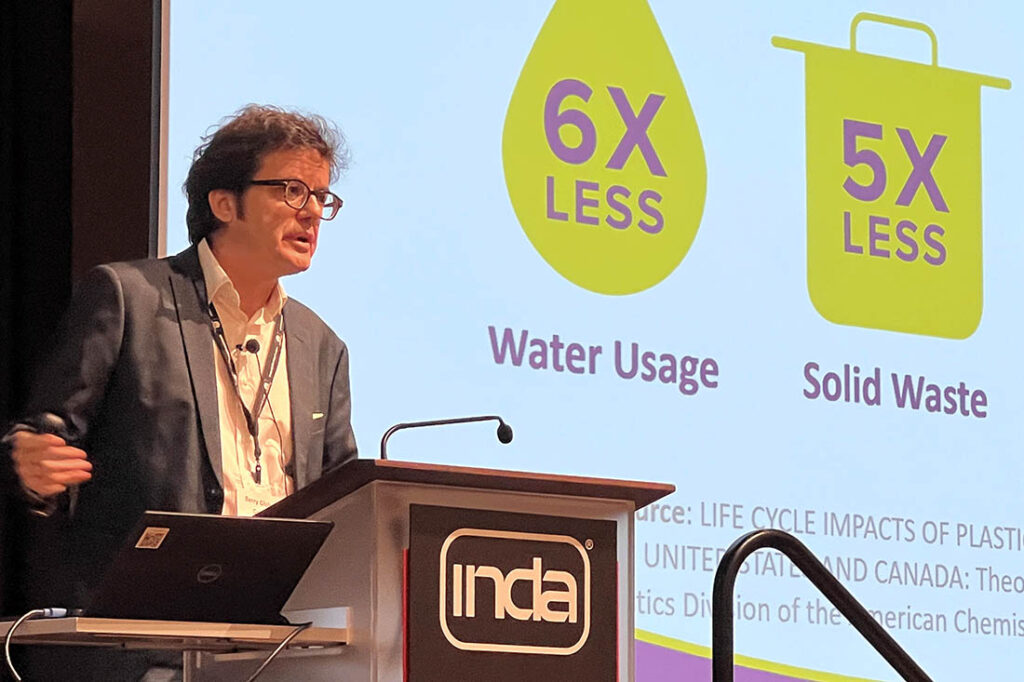RISE is the sustainability platform for emerging and nascent technologies in nonwovens. Held at the James B. Hunt. Jr. Library, North Carolina State’s award-winning library, in Raleigh, North Carolina on October 1-2, 2024, thought leaders spanning the entire supply chain will converge to discuss cutting-edge advancements and research. At RISE®, innovation merges with tangible real-world applications, transforming possibilities into nonwoven reality.
Attendees gain invaluable insights in:
- Advancements in Natural & Bio-Based Fibers
- Sustainability in Chemistry
- Energy Efficiencies in Machinery
- Advanced Recycling Techniques & Methods
- Current Events in Legislation & Regulation
Noteworthy Sessions:
Advancing Nonwovens Technology Using Artificial Intelligence
Rishi Gurani, Ph.D., Director of Software & Algorithms, Matmerize
The steam engine, the light bulb, and the Internet; these are among the handful of technologies that have shaped every industry, including nonwovens. With each passing day, it appears increasingly likely that artificial intelligence (AI) will leave a commensurate mark.
AI has already improved the development of novel materials and chemical formulations in academia and industry. To fully harness AI’s potential, strategic investments and planning are needed in a few key areas, including digitalization, data capture and management, as well as AI algorithms and their limitations. This presentation provides a comprehensive overview of those areas, culminating in impactful and value-added use cases in the nonwovens and polymeric materials domain.
The Recycling Landscape and Future of rPET
Don Walter, Director of R&D, Darling Fibers
Polyester has been an integral material in society for many years. Its properties can be engineered as tire cord for its strength and stability, designed for safe packaging for food and drink, and formed into various denier textiles for use in a myriad of end uses. Additionally, the low-cost and flexibility of polyester has made it a popular choice in many single-use products. Its durability is an asset in many cases but also creates a concern as products reach end-of-life. Untreated polyester does not degrade effectively in landfills which creates long-term environmental issues.
Sustainable technologies for PET are expanding quickly, and it is unlikely that any one method will optimally handle the variety of ecological challenges. This presentation will focus on recycling and discuss the practical challenges and benefits of the leading options. It will also layout some of the key hurdles in rPET production and usage in the near term.

Elastoester Polymer Enabling Sustainable Elastic Yarn & Fabrics
Carmen Covelli, Technical Laurate, Celanese
Neolast™ fiber is designed to offer elevated stretch performance while helping address sustainability challenges (including recyclability) associated with elastane, which is commonly referred to as spandex. Apparel designers can now create more sustainable power-stretch clothing that also delivers elite performance. Deolast(TM) fiber is melt spun using thermoplastic copolyester elastomer which is classified under the generic category of elastoester. The thermoplastic nature of the polymer enables melt processing, allowing fiber formation without the need for solvents. Celanese expertise in thermoplastic copolyester elastomer chemistry and formulation has led to innovation of two new grades of Neolast™ polymer created for fiber spinning.
Plastic Waste Crisis – Engineering Recyclable Materials for Tomorrow
Katrina Knauer, Ph.D., Senior Researcher & CTO of BOTTLE, NREL
The plastic pollution crisis is intrinsically tied to an energy crisis, with projections indicating that roughly 20% of fossil fuel consumption will be allocated to plastic production by 2050, accounting for nearly 15% of global greenhouse gas emissions (twice that of the aviation sector). Existing polymerization processes offer limited potential for efficiency enhancements and reducing energy demand. Moreover, reliance on mechanical recycling, the predominant method at scale, is hampered by its finite life cycles due to polymer degradation and contamination. In light of these challenges, the most promising avenues for decarbonizing the U.S. plastic industry necessitate comprehensive systemic transformations.
This involves integrating bio- and waste-based supply chains and establishing a circular economy loop for plastics through innovative recycling techniques aimed at reclaiming plastic waste. At the forefront of these efforts is the Bio-Optimized Technologies to keep Thermoplastics out of Landfills and the Environment (BOTTLE™) Consortium, a multi-organization initiative led by the U.S. Department of Energy.
This presentation will showcase the flagship technologies developed by the BOTTLE Consortium, including low-energy plastic deconstruction methods, innovative upcycling approaches for waste intermediates, and the development of recyclable-by-design (RBD) polymers poised to revolutionize the plastic industry landscape.
The Role of Biocomponent Extrusion on Sustainability
Tony De la Hoz, Director – R&D, Hills, Inc.
We are witnessing a significant surge in developmental efforts within the nonwovens sector aimed at crafting the next generation of materials. This momentum spans various segments of the industry, including hygiene, medical, filtration, apparel, furniture, acoustics, insulation, and more. Amidst this fervor for innovation, it is crucial to recognize that sustainability has emerged as the primary driving force propelling technology and materials forward.
In light of this paradigm shift, let us contemplate the implications of integrating bicomponent extrusion capabilities. This advancement not only facilitates the introduction of sustainable solutions or materials to the market but also enhances value proposition. By leveraging bicomponent extrusion, we can elevate innovation to unprecedented levels, augmenting product performance, durability, and efficiency. Furthermore, this technology holds the promise of reducing carbon footprints, conserving energy, and boosting production rates, thereby reshaping the landscape of the industry – a true game changer.
It is imperative to acknowledge that with the incorporation of bicomponent extrusion, the conventional approach to polymer utilization undergoes a fundamental transformation. Rather than viewing polymers in isolation, it becomes imperative to comprehend the synergistic potential inherent in combining distinct materials through bicomponent extrusion.
Tackling the Issues of PFAS Replacement in Nonwovens
Ross Ward, Ph.D., CCO, NIRI
The need for PFAS replacement is disrupting the nonwoven industry. Revised EU and U.S. regulations are on the horizon, and there is growing evidence that exposure contributes to organ disease, cancer, and reduced fertility. Companies are now challenged to explore options to reduce or eliminate their dependency on PFAS while maintaining product performance. This is no small undertaking, as no single route to PFAS replacement exists. Potential solutions will likely incorporate PFAS-free additives or coatings, intelligent fibre designs, and textile constructions.
This presentation will focus on strategies for intelligent fibre and nonwoven design, which can serve as a reference for manufacturers wishing to exploit application development approaches for PFAS replacement.
Plus:
How Adhesives Help You Exceed Performance & Sustainability Goals
Christophe Morel-Fourrier, Ph.D.,
Global Sustainability Leader, Bostik, Inc.
Opportunities for Large Scale Water Blocking with Super Absorbent Fibre (SAF) Technology
John Rose, Ph.D., Development Director, Technical Absorbents (UK)
Composition and Antimicrobial Activity of Hemp Fiber
Olaf Isele, Strategic Director of Product Development, Trace Femcare, Inc.
Is Global Plastic Regulation Happening & What Will it Look Like?
Wes Fisher, Director of Government Relations, INDA
The INDA Lifetime Technical Achievement Award will recognize an individual whose technical achievements, over a career of 20 years or more, have meaningfully contributed to the growth of the nonwovens industry. This technical professional will have a long history of innovation, INDA involvement, and/or commercial success.

For more information visit www.riseconf.net


